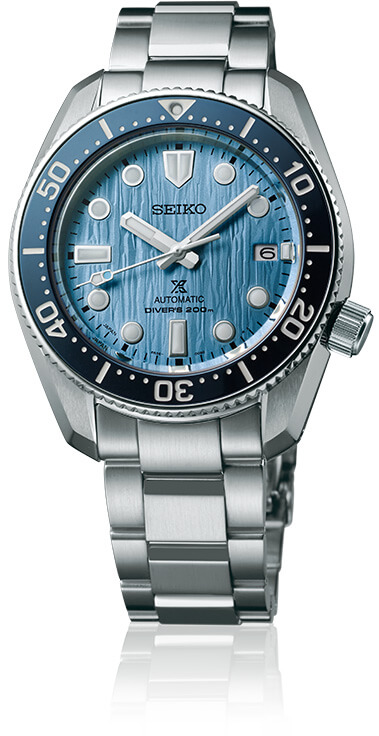No products in the cart.
SEIKO PROSPEX
1965 / 1968 / 1970 Diver's Modern Re-interpretation
Save the Ocean Special Editions
STORY
Seiko’s reputation for reliable and durable diver’s watches was forged in the 1960’s and 1970’s when they were chosen by adventurers and researchers on expeditions to the north and south poles. Today, Seiko introduces into the Prospex collection modern re-interpretations of three legendary diver’s watches from this period that draw their design inspiration from the glaciers that these pioneers saw and that shape the landscapes and seascapes of the Arctic and Antarctic. Each one has a dial that evokes a different shade of glacial ice, from deep blue to white.
1965 / 1968 / 1970 Diver's Modern Re-interpretation
Save the Ocean Special Editions

1965

1968

1970
1965
Diver's Modern Re-interpretation
Save the Ocean Special Editions


1965 Original model
The 1965 diver’s watch incorporated an automatic mechanical caliber and delivered 150m water resistance. The watch was designed for maximum reliability and legibility in the harshest conditions. It proved its reliability when used in the Antarctic during the 60s and laid the path to the development of future landmark watches.
Deep Blue Dial
The power and beauty of polar glaciers are captured perfectly in the intricately patterned dials. The rich heritage of the 1965 diver’s watch is represented in the deep blue color of the dial.

SEIKO PROSPEX
1965 Diver's Modern Re-interpretation
Save the Ocean Special Edition
1968
Diver's Modern Re-interpretation
Save the Ocean Special Editions

1968 Original model
The landmark 1968 diver’s was Seiko’s first watch with 300m water resistance and a 10-beat automatic movement. With a one-piece structure, a mono-directional rotating bezel and screw-down protection crown, this timepiece pushed back the frontiers of precision, durability and ease of use in watches for professional and recreational divers.

Light Blue Dial
A light blue dial and a darker blue bezel grace the new modern re-interpretation of the landmark 1968 diver’s watch. The dial and bezel colors evoke the magnificent landscape of Antarctica.
SEIKO PROSPEX
1968 Diver's Modern Re-interpretation
Save the Ocean Special Edition
1970
Diver's Modern Re-interpretation
Save the Ocean Special Editions


1970 Original model
In 1970, Seiko introduced a diver’s watch whose asymmetrical extension protected the crown at the four o’clock position. Its solid construction, luminous hands and indexes and 150 meter water resistance were perfect for those who required a timepiece with exceptional strength and visibility. The watch proved its reliability in extreme conditions when it was worn by the Japanese adventurer, Naomi Uemura, in the years 1974 to 1976 when he completed a 12,500km solo dog-sled run from Greenland to Alaska.
White Dial
A white dial capturing the glacial seascape of the Artic is encased in the same distinctive shaped case as the 1970 classic which proved its strength and endurance when worn by the Japanese adventurer Naomi Uemura.
SEIKO PROSPEX
1970 Diver's Modern Re-interpretation
Save the Ocean Special Edition
Seiko Prospex supports various marine conservation activities through its “Save the Ocean” initiative to preserve and protect the ocean for future generations and give back to the diver’s community. This initiative will be conducted with Sustainable Development Goal 14, to “conserve and sustainably use the oceans, seas and marine resources for sustainable development,” in mind.

Play Video

STORY
Seiko’s reputation for reliable and durable diver’s watches was forged in the 1960’s and 1970’s when they were chosen by adventurers and researchers on expeditions to the north and south poles. Today, Seiko introduces into the Prospex collection modern re-interpretations of three legendary diver’s watches from this period that draw their design inspiration from the glaciers that these pioneers saw and that shape the landscapes and seascapes of the Arctic and Antarctic. Each one has a dial that evokes a different shade of glacial ice, from deep blue to white.
1965 / 1968 / 1970 Diver's Modern Re-interpretation Save the Ocean Special Editions

1965

1968

1970
1965
Diver’s Modern Re-interpretation
Save the Ocean Special Edition


1965 Original model
The 1965 diver’s watch incorporated an automatic mechanical caliber and delivered 150m water resistance. The watch was designed for maximum reliability and legibility in the harshest conditions. It proved its reliability when used in the Antarctic during the 60s and laid the path to the development of future landmark watches.

Deep Blue Dial
The power and beauty of polar glaciers are captured perfectly in the intricately patterned dials. The rich heritage of the 1965 diver’s watch is represented in the deep blue color of the dial.
SEIKO PROSPEX
1965 Diver's Modern Re-interpretation Save the Ocean Special Edition
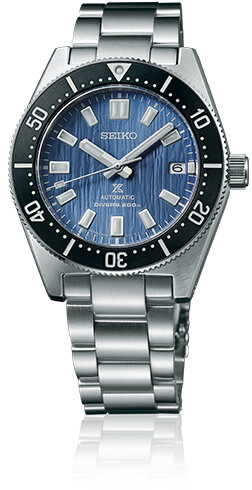
1968
Diver’s Modern Re-interpretation
Save the Ocean Special Edition

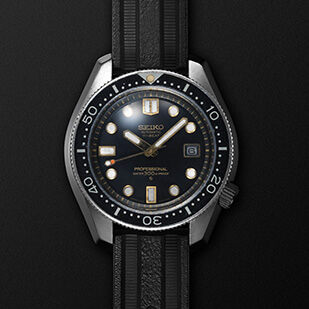
1968 Original model
The landmark 1968 diver’s was Seiko’s first watch with 300m water resistance and a 10-beat automatic movement. With a one-piece structure, a mono-directional rotating bezel and screw-down protection crown, this timepiece pushed back the frontiers of precision, durability and ease of use in watches for professional and recreational divers.

Light Blue Dial
A light blue dial and a darker blue bezel grace the new modern re-interpretation of the landmark 1968 diver’s watch. The dial and bezel colors evoke the magnificent landscape of Antarctica.
SEIKO PROSPEX
1968 Diver's Modern Re-interpretation Save the Ocean Special Edition

1970
Diver’s Modern Re-interpretation
Save the Ocean Special Edition


1970 Original model
In 1970, Seiko introduced a diver’s watch whose asymmetrical extension protected the crown at the four o’clock position. Its solid construction, luminous hands and indexes and 150 meter water resistance were perfect for those who required a timepiece with exceptional strength and visibility. The watch proved its reliability in extreme conditions when it was worn by the Japanese adventurer, Naomi Uemura, in the years 1974 to 1976 when he completed a 12,500km solo dog-sled run from Greenland to Alaska.

White Dial
A white dial capturing the glacial seascape of the Artic is encased in the same distinctive shaped case as the 1970 classic which proved its strength and endurance when worn by the Japanese adventurer Naomi Uemura.
SEIKO PROSPEX
1970 Diver's Modern Re-interpretation Save the Ocean Special Edition
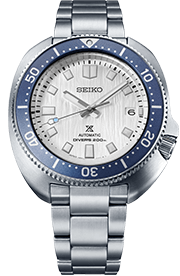
Seiko Prospex supports various marine conservation activities through its “Save the Ocean” initiative to preserve and protect the ocean for future generations and give back to the diver’s community. This initiative will be conducted with Sustainable Development Goal 14, to “conserve and sustainably use the oceans, seas and marine resources for sustainable development,” in mind.
Play Video

STORY
Seiko’s reputation for reliable and durable diver’s watches was forged in the 1960’s and 1970’s when they were chosen by adventurers and researchers on expeditions to the north and south poles. Today, Seiko introduces into the Prospex collection modern re-interpretations of three legendary diver’s watches from this period that draw their design inspiration from the glaciers that these pioneers saw and that shape the landscapes and seascapes of the Arctic and Antarctic. Each one has a dial that evokes a different shade of glacial ice, from deep blue to white.
1965 / 1968 / 1970 Diver's Modern Re-interpretation Save the Ocean Special Editions

1965

1968
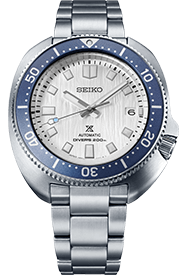
1970
1965
Diver's Modern Re-interpretation Save the Ocean Special Edition
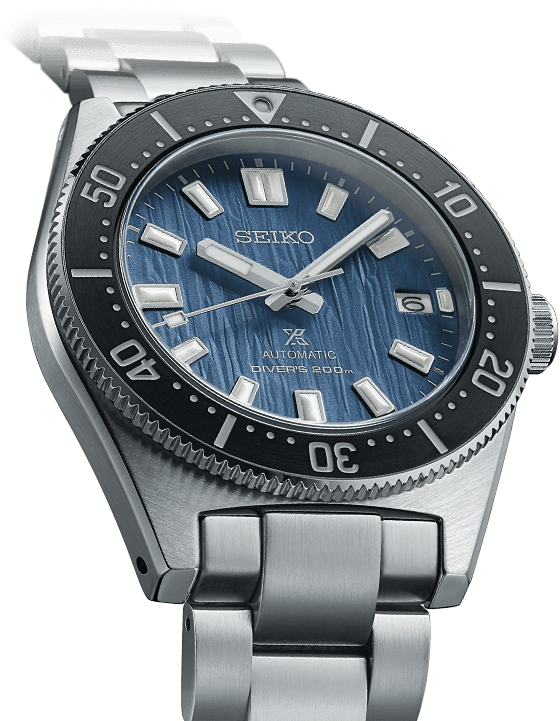

1965 Original model
The 1965 diver’s watch incorporated an automatic mechanical caliber and delivered 150m water resistance. The watch was designed for maximum reliability and legibility in the harshest conditions. It proved its reliability when used in the Antarctic during the 60s and laid the path to the development of future landmark watches.

Deep Blue Dial
The power and beauty of polar glaciers are captured perfectly in the intricately patterned dials. The rich heritage of the 1965 diver’s watch is represented in the deep blue color of the dial.
SEIKO PROSPEX 1965 Diver's Modern Re-interpretation Save the Ocean Special Edition

1968
Diver's Modern Re-interpretation Save the Ocean Special Edition

1968 Original model
The landmark 1968 diver’s was Seiko’s first watch with 300m water resistance and a 10-beat automatic movement. With a one-piece structure, a mono-directional rotating bezel and screw-down protection crown, this timepiece pushed back the frontiers of precision, durability and ease of use in watches for professional and recreational divers.


Light Blue Dial
A light blue dial and a darker blue bezel grace the new modern re-interpretation of the landmark 1968 diver’s watch. The dial and bezel colors evoke the magnificent landscape of Antarctica.
SEIKO PROSPEX 1968 Diver's Modern Re-interpretation Save the Ocean Special Edition

1968
Diver's Modern Re-interpretation Save the Ocean Special Edition


1970 Original model
In 1970, Seiko introduced a diver’s watch whose asymmetrical extension protected the crown at the four o’clock position. Its solid construction, luminous hands and indexes and 150 meter water resistance were perfect for those who required a timepiece with exceptional strength and visibility. The watch proved its reliability in extreme conditions when it was worn by the Japanese adventurer, Naomi Uemura, in the years 1974 to 1976 when he completed a 12,500km solo dog-sled run from Greenland to Alaska.

White Dial
A white dial capturing the glacial seascape of the Artic is encased in the same distinctive shaped case as the 1970 classic which proved its strength and endurance when worn by the Japanese adventurer Naomi Uemura.
SEIKO PROSPEX 1970 Diver's Modern Re-interpretation Save the Ocean Special Edition

Seiko Prospex supports various marine conservation activities through its “Save the Ocean” initiative to preserve and protect the ocean for future generations and give back to the diver’s community. This initiative will be conducted with Sustainable Development Goal 14, to “conserve and sustainably use the oceans, seas and marine resources for sustainable development,” in mind.
Play Video



